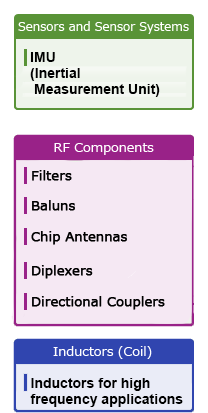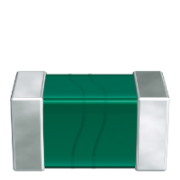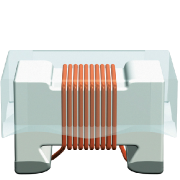Application Note"Vehicle-to-Vehicle and Infrastructure-to-Vehicle Communication" (V2X) to Realize Autonomous Driving Technology
The evolution of sensing technology and communication network contribute to the realization of Autonomous driving society and its growth. In association with full-scale expansion of the "5G service" next-generation wireless communication standard, great attention is being placed on wireless technology intended for "vehicle-to-vehicle and infrastructure-to-vehicle communication" (V2X) to communicate data between automobiles and their surroundings. While the TDK Group can offer a lineup of various electronic components for V2X, this article introduces a selection of IMU (Inertial Measurement Unit) and high-frequency products for Telematics Control Units (TCUs).Contents
Telematics Control Units (TCUs)
The Autonomous Driving society is coming to the reality in order to reduce the number of casualties caused by traffic accidents and improve the level of convenience of mobility services. In addition to cameras, millimeter-wave radar, and LiDAR, autonomous vehicles must be equipped with communication functions provided by equipment known as Telematics Control Units (TCU), devices which communicate with vehicles using wireless methods to exchange vehicle-to-infrastructure and vehicle-to-vehicle information. TCUs include GNSS (Global Navigation Satellite System), cellular and Wi-fi antennas, and IMUs (Inertial Measurement Units). These IMUs use methods such as SLAM (Simultaneous Localization and Mapping) and "dead reckoning" (estimated navigation) which can detect precise vehicle positioning if GNSS signals are interrupted by tunnels, overhead crossings, underground locations, high-rise buildings, or other shielding conditions.
IMUs (Inertial Measurement Units)
IMUs (Inertial Measurement Units) are combined devices which integrate 3-axis gyro sensors and 3-axis acceleration sensors for detecting precise vehicle positioning into a single chip, and are able to achieve the highest level of performance in the industry with outstanding noise characteristics, temperature stability, sensitivity, and precision. These properties are key elements for the development of applications including navigation, Telematics Control Units, and locators. Furthermore, these products are equipped with advanced programmable multi-interface devices which can be supplemented with external sensors such as pressure gauges and barometers.
| Part Number | IAM-20680 |
|---|---|
| Axis | 6-Axis IMU (3-axis GYR + 3axis XL) |
| Dimensions: LxWxT(Nom) / mm | 3 x 3 x 0.75 |
| Digital Output | I²C, SPI |
| VDD Power Supply Voltage / V | 1.71 to 3.6 |
| Gyro FSR / (°/sec) | ±250/500/1000/2000 |
| Gyro Sensitivity Error | 131/65.5/32.8/16.4 |
| Gyro Rate Noise / (dps/√Hz) | 0.005 |
| Acceleration FSR / g | ±2/4/8/16 |
| Acceleration Sensitivity Error | 16384/8192/4096/2048 |
| Operating Temperature Range / ℃ | -40 ~ 85 |
| Automotive Standard (AEC) | AEC-Q100 |
High-Frequency Products
Automotive Chip Antennas/Filters, Baluns, Diplexers, and Directional Couplers
During autonomous driving, automobiles must have wireless connections established using cellular signals or DSRC connection and perform two-way infrastructure-to-vehicle and vehicle-to-vehicle communication to detect obstacles or other approaching vehicles which cannot be seen, and TDK's ANT antenna series can serve to support this in-vehicle connectivity. The ANT series of ceramic chip antennas is characterized by a compact, low-profile design achieved through a unique structure which uses low-temperature co-fired ceramics (LTCC) technology. Products in the ANT series are small and thin with no loss of performance or reliability, contributing to reduced space requirements with an antenna area among the smallest in the industry and allowing significant simplification and efficiency improvement during board revisions at each stage of board design and development.
In addition to chip antennas, TDK's lineup includes filters, baluns, diplexers, and directional couplers. Please use these products according to the operating temperature ranges indicated in their catalogs, specifications, and other materials, and inquire with us for further details.
Click part number in the diagram for more details.
| Chip Antenna Mounting Guideline |
Application | Frequency Band | ||||
|---|---|---|---|---|---|---|
| Sub GHz Band | GNSS Band | 2.4GHz Band | 5GHz Band | |||
PCB Center-edge Mounting Position |
Mount besides corner of PC Board |
Single Band |
ANT161575DT-2000AM11574-1576MHz / 2400-2484MHz |
ANT162442ST-1000AM12400-2484MHz |
ANT165550ST-1003AM15150-5950MHz |
|
Dual Band |
ANT161575DT-2000AM11574-1576MHz / 2400-2484MHz |
|||||
ANT162442DT-2001AM22400-2484MHz / 5150-5850MHz |
||||||
PCB Corner Mounting Positions |
Mount at corner of PC Board
|
Single Band |
ANT161575DT-2000AM1*11574-1576MHz / 2400-2484MHz |
ANT162442ST-1201AM12400-2484MHz |
ANT165550ST-1003AM1*15150-5950MHz |
|
Dual Band |
ANT161575DT-2000AM1*11574-1576MHz / 2400-2484MHz |
|||||
ANT162442DT-2001AM2*12400-2484MHz / 5150-5850MHz |
||||||
*1 : Please mount at near the corner of PC Board for these items.
Inductors for Automotive High-Frequency Circuits
TDK's high-frequency inductors are laminated-type inductors which have achieved higher inductance, higher Q values, and even smaller sizes through our unique multilayer board process technology. They play extremely important roles in achieving robust connectivity through stable signal transmission.
Click part number in the diagram for more details.
- Commercial Grade
- Automotive Grade
- Multilayer
| Category | 0.4mm x 0.2mm [EIA 01005] |
0.6mm x 0.3mm [EIA 0201] |
1.0mm x 0.5mm [EIA 0402] |
1.6mm x 0.8mm [EIA 0603] |
2.0mm x 1.2mm [EIA 0805] |
||||||||||
|---|---|---|---|---|---|---|---|---|---|---|---|---|---|---|---|
| For RF Matching Circuit |
Critical Matching
| Super High Q |
MHQ0402PSA0.2 to 22nH |
MHQ0603P0.6 to 39nH |
MHQ1005P0.7 to 560nH |
B82496C
|
B82498F3
|
||||||||
Normal Matching
|
High Q |
MLG0402P0.2 to 33nH |
MLG0603P0.6 to 120nH |
||||||||||||
Standard Q |
MLG0603S0.3 to 180nH |
MLG1005S0.3 to 390nH |
|||||||||||||
| For Bias Circuit | High Current |
MLG0603PPA2.2 to 4.7nH |
|||||||||||||
Summary
To achieve the goals of greater safety and comfort for autonomous driving and our automobile-oriented society, vehicles must be equipped with cameras, various sensors, and wireless communication functions. TDK can provide electronic components to make such communication functions and self-position estimation functions more reliable and stable. Please inquire separately if you are investigating high-frequency products other than chip antennas and inductors which are not specifically designated as automotive products.
Contact Information
Related Links
Product Portals
- IMU (Inertial Management Unit) Product Information
- Comprehensive guide to information on IMUs (Inertial Management Units) from the TDK Group.
- RF Components and Modules Product Information
- Comprehensive guide to information on RF Components and Modules from the TDK Group.
- Inductor (Coil) Product Information
- Comprehensive guide to information on Inductors (Coils) from the TDK Group.

















